Etteilla: The First Modern Card Reader and His Reconstructed Decks by Marco Benedetti
Let’s celebrate Etteilla, the eighteenth-century cartomancer who laid the groundwork for our contemporary tarot reading practices. After writing numerous books on divination, seeing clients, running a school, and establishing a tarot society, he found time to design a tarot deck that has been in print, in slightly altered form, for over 200 years. Now for the first time, thanks to Marco Benedetti’s reconstruction, Etteilla’s original tarot deck, as he conceived it, is available to the public. Before taking a close look at Etteilla’s tarot, we’ll review his amazing career.
Etteilla’s Early Career
Jean-Baptiste Alliette (Etteilla is his last name spelled backward) was born in 1738 to a family of Parisian grocers and caterers. As a teenager, he learned to tell fortunes with playing cards; and in 1757 he began studying tarot with some elderly Italian card readers. He established a shop in Paris where he sold art prints and tarot decks imported from eastern France. By 1770, he had a flourishing business as a card reader and had acquired a circle of students. He styled himself “Professor of Algebra” with a public persona as an all-purpose magus. A surviving price list shows him offering horoscopes, card readings, dream interpretation, amulets, and metaphysical lessons.
Etteilla innovated several card reading techniques that have become standard practice. In his day, a fortune-teller would take cards off the top of the deck, one-by-one, and read them individually. Etteilla pioneered laying cards out in a spread to tell an integrated story, modifying a card’s interpretation with adjacent cards, reading reversals, and associating each suit with a different topic.
In 1770, Etteilla published the world’s first systematic approach to card reading, Manière de se récréer avec un jeu des cartes (A Way of Entertaining Yourself with a Deck of Cards). He used a 32-card Piquet deck, a standard French-suited deck with cards two through six removed from each suit, and with the addition of an extra card, a significator he called “Etteilla”. The book presented elaborate spreads laid out in squares, semi-circles and zodiac wheels. His card interpretations served as the foundation for the minor arcana of his tarot deck, and influenced future generations of card readers, including A. E. Waite.
The Petit Etteilla Deck
It wasn’t until 1791, the last year of his life and two years after publishing his tarot deck, that Etteilla produced a deck based on the system set out in his 1770 book. A few months later, he issued his last publication, Etteilla, ou l’art de lire dan les cartes (Etteilla: Or the Art of Card Reading) a final summary of his career and his teachings, making this one of the first deck and book sets.
The deck, known as Petit Etteilla, features standard French-suited playing cards set in very wide borders containing handwritten keywords and other instructions taken directly from the 1770 book. Upright and reversed keywords appear on the top and bottom borders. The side borders give interpretations for multiples of the card in a spread.
Facsimile Petit Etteilla by Marco Benedetti
The nineteenth-century was a golden age for fortune-telling and oracle decks. The Petit Etteilla was reprinted many times by Grimaud and other publishers. Since the deck is based on standard playing cards, it’s not important which deck is used—but the keywords are crucial. These have remained remarkably stable and are nearly identical in all versions of the deck.
Benedetti has published a facsimile of one of the many nineteenth-century Petit Eetteilla decks still extant. The cards are 2.25 x 3.5 inches. The two layers of card stock feature smooth paper for the back and textured art paper for the front. The cards are substantial without being bulky, and their soft texture makes them easy to shuffle. The deck is housed in a sturdy telescope box printed in the style of nineteenth-century packaging.
Etteilla’s Later Career
During the last decade of his life, Etteilla produced a constant stream of books and leaflets on tarot, astrology, divination, and his ideas for improving living conditions in those turbulent years leading up to the French Revolution. His immediate inspiration may have been the writings of Antoine Court de Gébelin. In the last segment of his multi-volume work, Le Monde Primitif, de Gébelin included two essays on tarot. He revealed that the major arcana images of the Tarot de Marseille are actually Egyptian hieroglyphs that transmit ancient Egyptian wisdom from humanity’s golden age. In addition, the cards correspond to the twenty-two letters of the Hebrew alphabet.
Etteilla was totally spellbound by the myth sweeping through occult circles of his day—the belief that tarot was invented by Egyptian magi under the guidance of Hermes Trismegistus. He believed the first tarot deck had been engraved on leaves of gold and deposited at an altar of fire near Memphis. These gold leaves were the only survivors of a fire that destroyed ancient Egypt’s library, meaning tarot cards are humanity’s only link to the wisdom teachings of the world’s most ancient civilization. Etteilla referred to the tarot deck as the Livre de Thoth (Book of Thoth) and he believed it to be a seventy-eight page book, not a deck of cards.
Etteilla’s enthusiasm for spreading the word about Egyptian tarot led him to found the Société des Interprètes du Livre du Thoth (Society of the Interpreters of the Book of Thoth). Many prominent occultists were members of the world’s first organization dedicated to tarot. Two years later, Etteilla and his son founded Nouvelle Ecole de Magie (The New Magic School) where he taught tarot, astrology and alchemy.
Etteilla’s greatest contribution to esoteric tarot was his four-volume work on the Book of Thoth, and its companion deck published a few years later (the first book and deck set). The book, Manière de se récréer avec le jeu de cartes nommées tarots (A Way of Entertaining Yourself with the Deck of Cards Called Tarot) was issued in four volumes from 1783 to 1785. The title is nearly identical to his cartomancy book published over a decade earlier. It seems like a rather flippant title for a work that transmits ancient spiritual wisdom. But in Etteilla’s day, books needed a stamp of approval from the royal censor before they could be published. Etteilla’s first book on tarot had been rejected by the censor a few years earlier. Perhaps this title was an attempt to make his tarot book seem like a frivolous work on fortunetelling that wouldn’t attract the censor’s attention.
Etteilla’s Tarot Deck: Le Livre de Thoth
This tarot deck, commonly known as the Grand Etteilla, is the summation of Etteilla’s extensive experience as a card reader, as well as his spiritual beliefs about tarot. The card illustrations arise from his belief that tarot is a wisdom book created by ancient Egyptian magi, and that it needs to be purged of Christian distortions and returned to its original Egyptian purity. He numbered the cards in sequence from zero to seventy-seven, like pages in a book. He used Arabic numbers because he believed they were Egyptian; and he numbered the Fool zero because he believed Egyptians invented the zero. Actually, there is almost nothing Egyptian in the deck. The monument on card #2, Eclaircissement, may be Etteilla’s attempt to depict Egyptian architecture. Most of what passed for knowledge about Egypt was pure fantasy until Napoleon invaded the country in 1798 and sponsored a scientific expedition.
For centuries, nearly all playing cards were printed with wood blocks. Etteilla’s tarot takes its place among the few luxury decks, like Sola Busca, Mitelli, and Soprafino, that were printed with finely engraved copper plates. Etteilla must have collaborated with an artist to ensure that his vision for each card was faithfully executed; just as A. E. Waite collaborated with Pamela Colman Smith to create his major arcana in the early twentieth century. The printing was done in the workshop of Pierre-François Basan, a prominent Parisian engraver. The final product, a limited-edition luxury deck, was intended for Etteilla’s students and members of his tarot society. The deck was published about March 1, 1789 (Etteilla’s birthday) on eight large sheets of paper which could be folded into a booklet, or cut into individual cards to make a deck.
Always the practical businessman, Etteilla placed ads on the borders of three cards. On the Eight of Batons it says “Etteilla, professor of algebra, renewer of cartonomancy, and redactor of modern errors in the ancient Book of Thot, living at #46, Rue de L’Oseille, Paris”. On the Two of Batons he advertises his two-volume book on “Tharoth”: 1200 pages, many images, price 12 livres. The ad on the Eight of Coins announces that Etteilla will teach you fortune-telling with Egyptian cards, six lessons costing three livres each.
Shortly after Etteilla’s death, one of his senior students seized his papers and decks and declared himself the successor to Etteilla’s legacy. He scratched out Etteilla’s name and address on the Eight of Batons, substituted his own name, and continued selling the decks. When he ran out of the first print run, he commissioned a block-printed version with some minor changes, and his own name and address in the borders. Subsequent nineteenth-century publications omit the advertising and make even more changes to the images and keywords. When we see Etteilla’s name and address on the border of the Eight of Batons, we can be confident we’re looking at Etteilla’s original deck.
The deck was accompanied by a four-page leaflet, making this the first deck with an LWB (Little White Book). Unfortunately, this leaflet is the first in a long line of totally unhelpful LWBs that do little to illuminate their associated deck. Etteilla was criticized for his poor writing style, with good reason. His vocabulary is basic, but the resulting word salad is nearly indecipherable. In the booklet, he seems to be justifying divination as a route to wisdom and a connection to the divine. Then he gives a sample reading using this line of cards:

He instructs us to lay the eight cards out left to right, then read them right to left, like an Egyptian. He interprets the spread by stringing keywords together to make this meandering sentence: “There will arrive presently a letter, if you acquire prudence, a community, by supporting you, will facilitate your success, which will bring you riches.” I Hope his in-person readings were less cryptic and mechanical than this brief example.
One of Etteilla’s associates acquired a deck that was water-colored in soft, delicate tones. They cut the central image out of each card, discarding the borders with keywords, then arranged the images in the tableau shown here. Cards two through ten of each suit make up the square border. The Major Arcana cards are arranged in five decreasing rows starting at the top, and ending with the Fool at bottom center. The court cards are arranged in squares of four, with the Ace of their suit below each set. The title at the top says “The leaves of the book of Thoth that were placed in the temple of fire at Memphis.” An engraving of Etteilla at his work table is at bottom center.
Etteilla’s Original Deck Recreated by Marco Benedetti
Until now, no complete, colored deck designed by Etteilla himself has been available. Benedetti is the first to see the possibility of combining the hand-painted images from the tableau above with the borders of a set of original cards printed in black-and-white with Etteilla’s keywords and advertisements. The hand-painted cards are in excellent condition, so no restoration was needed before placing them in their corresponding borders.
The cards are 2.5 x 4.75 inches, on two layers of paper: 220 gpm smooth card stock for the backs, and textured art paper for the front. These cards have the velvety feel of antique cards, which makes them very pleasant to shuffle. The deck is accompanied by a facsimile of Etteilla’s leaflet.
Purchase a custom printed deck by contacting Benedetti through Facebook, or sending him an email at Benedetti.Tarot @ Gmail.com.
Etteilla’s Tarot: Details of the Cards
Major Arcana
The first twelve trump cards contain an overlapping array of symbols: The seven days of creation, the four cardinal virtues, twelve zodiac signs, four elements, and divinatory keywords. For example: Card number 4 in the sequence represents the second day of creation, the element Air, and the zodiac sign Cancer. Its keyword is “Depouillement” (being stripped bare, or shedding one’s clothes). The image is nearly identical to the TdM Star card.
Seventeen of the twenty-two major arcana bear some resemblance to Tarot de Marseille imagery, but they are not in the standard order. Attempts to correlate Etteilla’s cards with corresponding TdM cards can lead to madness. Etteilla’s deck should be treated as a unique product arising from one man’s beliefs about tarot, and shouldn’t be forced to conform to other systems.
Court Cards
Etteilla followed de Gébelin in assigning each suit to a social class: Batons/farmers, Cups/clergy, Swords/nobles, and Coins/merchants. The clothing in each suit is color-coded. The figures resemble TdM court cards, but their posture is more graceful and dynamic. Many keywords are the same as their corresponding Petit Etteilla cards.
Pip Cards
The bottom third of each pip card is a yellow panel that’s empty in the suits of Swords and Cups. The suit of Batons has long nails arranged in different configurations, and the Coins have astrological figures. The blue upper portion of each card contains the suit symbols.
The upright keywords for cards 7 through 10 of each suit are the same in both the Grand and Petit Etteilla decks, with some glaring exceptions. The reversed keywords on cards 7 through 10 of Petit Etteilla are used for the upright keywords of cards 2 through 5 of the Grand Etteilla, again with exceptions that seem to be arbitrary.
Etteilla’s Legacy
Etteilla demonstrated with his own practice that the same tarot deck can be used for both card reading and metaphysical studies. If not for this synthesis, cartomancy may have evolved on two parallel tracks: esoteric studies with the Tarot de Marseille and its derivatives like the Oswald Wirth tarot; and fortune-telling with oracle decks like Lenormand and Kipper. Etteilla’s tarot deck is the forerunner of many contemporary decks based on hermeticism, alchemy or Kabbalah, that are used for study as well as divination.
Etteilla’s reputation declined in the nineteenth century, thanks to being publicly mocked by prominent occultists like Eliphas Levi. Much of it was class snobbery. Etteilla was called a hairdresser (he wasn’t) and ridiculed for his turgid writing style and lack of formal education. Fellow occultists were horrified by the absence of Hebrew letters on his cards, as well as their eccentric order. Rather than appreciating Etteilla’s unique system, they dismissed him as an ignorant fool who tarnished the sacred tarot deck by using it to read for lovesick housemaids. Etteilla’s theories were overshadowed by the prevailing emphasis on correspondences with the Hebrew alphabet and Tree of Life. When the Golden Dawn and Waite-Smith tsunami overtook the English-speaking world, Etteilla’s reputation shrank even more, until he became side-lined as a nearly-forgotten historic curiosity.
Arthur E. Waite was one of the prominent occultists who enjoyed sneering at Etteilla while shamelessly plagiarizing his card meanings. Researcher James Revak counted up the keywords that appear on Etteilla’s cards and in Waite’s book, Pictorial Key to the Tarot. Nearly half the keywords appear in both places. If Waite’s divinatory meanings for his minor arcana sometimes read like a jumble of disconnected words with little correlation to the card image, it’s because Waite lifted many of his keywords from Etteilla. Here are cards from both Etteilla’s and Waite’s decks that share upright and reversed meanings still in common usage today.
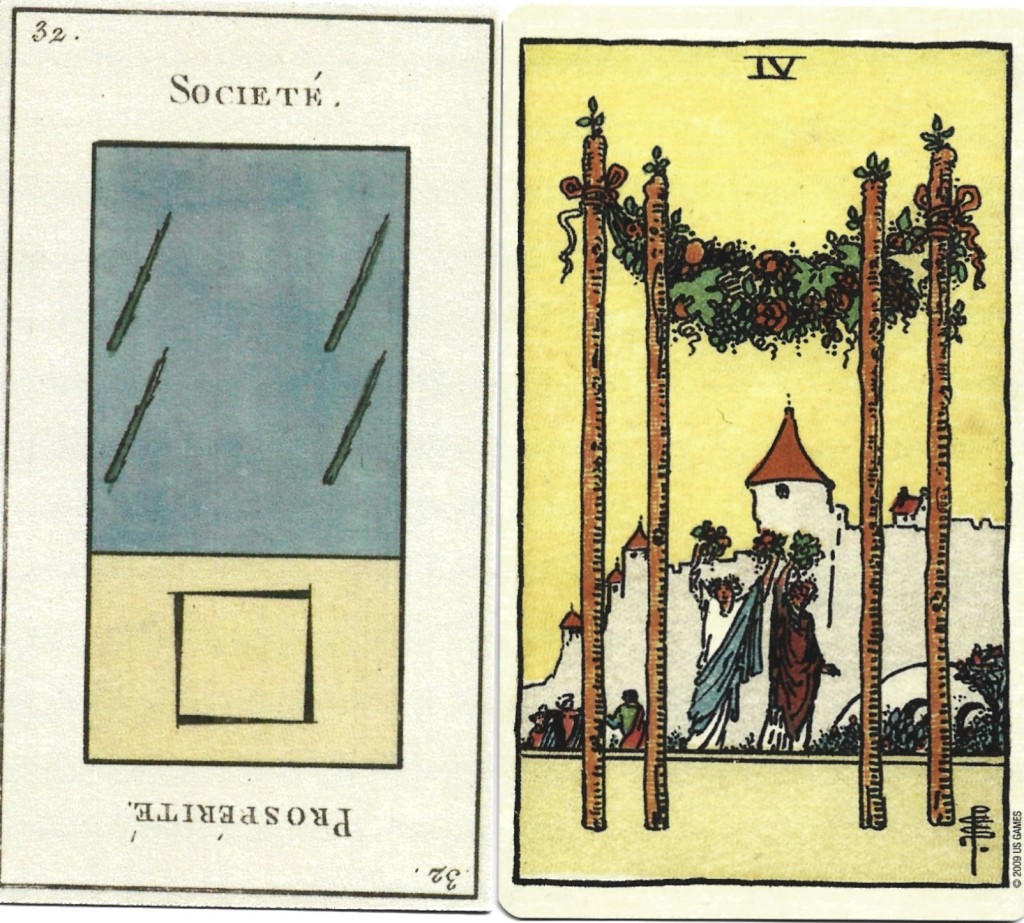
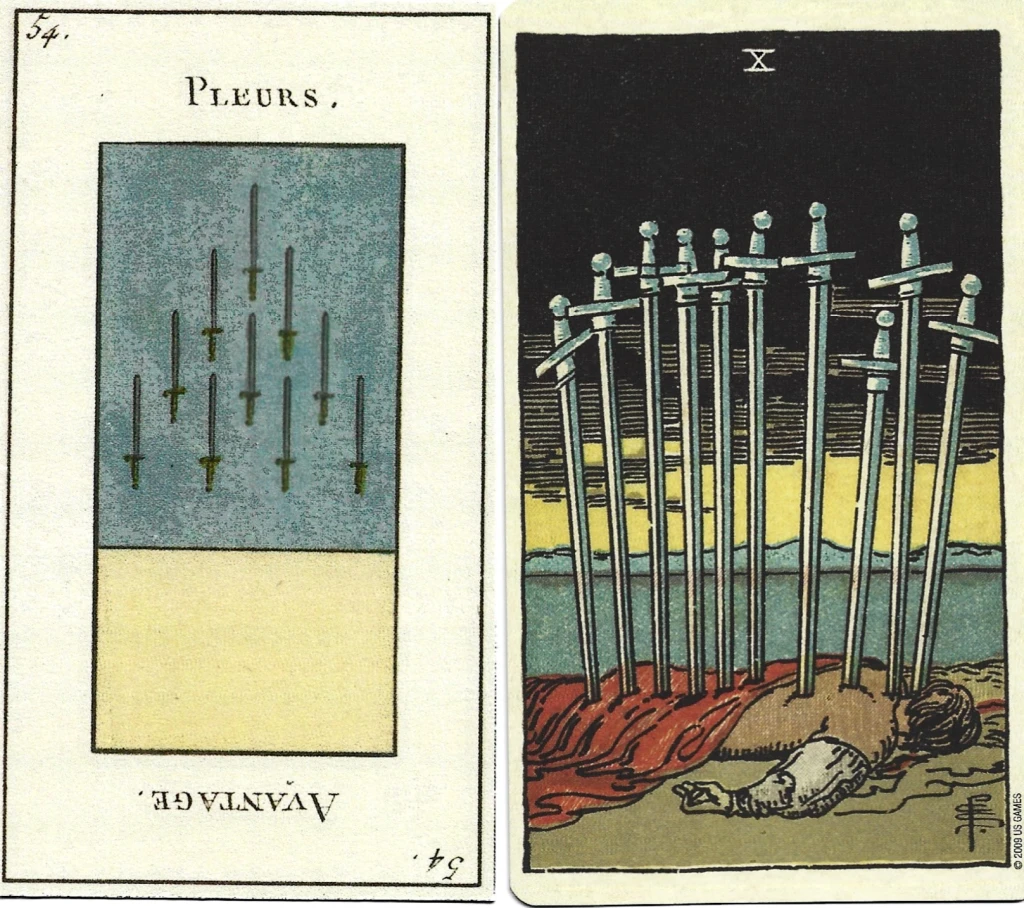
When we lay out cards in a spread with some cards reversed, then observe how adjacent cards influence each other, we are using Etteilla’s ground-breaking methods. When we interpret the Queen of Swords as an unpleasant woman, the Three of Wands as launching an enterprise, and the Two of Cups as love and desire, we are using Etteilla’s card meanings. Modern card readers constantly draw on the rich legacy of the man who elevated divination to a respected profession while bridging the worlds of fortune-telling and metaphysics.
All Etteilla cards illustrated here are from Etteilla: Livre de Thoth, and Petit Etteilla, restored and printed by Marco Benedetti. Rome, Italy, March 2024. Purchase a custom printed deck by contacting Benedetti through Facebook, or sending him an email at Benedetti.Tarot@gmail.com.
References
Waite Smith cards: The Centennial Waite Smith Tarot Deck. London, 1909. U.S. Games System, Inc., Stamford, CT, 2009.
The engraving of Etteilla at his desk first appeared in his 1790 book, Cours théorique et pratique du Livre de Thot.
Barbier, Laetitia. Tarot and Divination Cards: A Visual Archive. New York:Abrams, 2021.
Decker, Ronald. The Esoteric Tarot. Quest Books, 2013.
Decker, Ronald, Thierry DePaulis and Michael Dummett. A Wicked Pack of Cards: The Origins of the Occult Tarot. St. Martin’s Press, 1996.
Kaplan, Stuart R., Encyclopedia of Tarot, Volumes I and II. US Games Systems, Stamford, CT, 1978 and 1986.
Why Etteilla was disrespected and erroneously called a hairdresser:
https://tarot-heritage.com/2016/09/05/tarot-history-rant-5-etteilla-the-hairdresser/#more-1445
Articles by James Revak
https://www.villarevak.org/index.htm
https://www.villarevak.org/emw/emw_1.htm
https://www.villarevak.org/td/td_1.htm

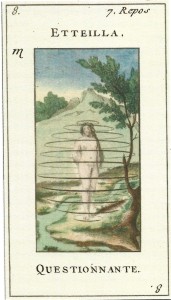
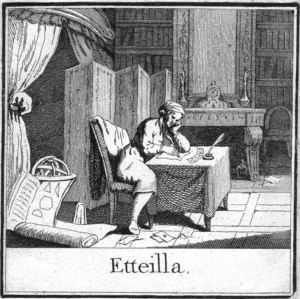
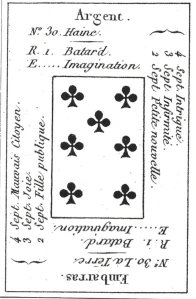
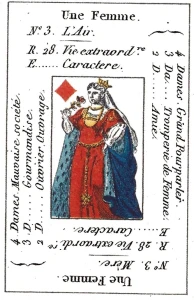
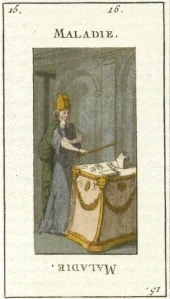
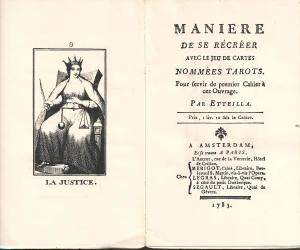
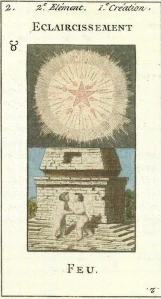
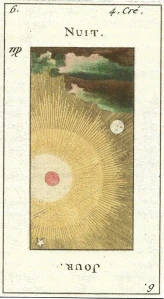
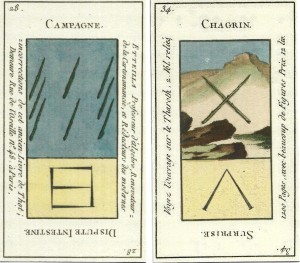
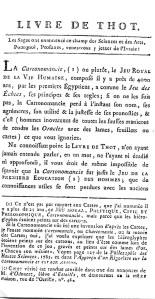
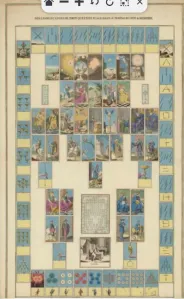
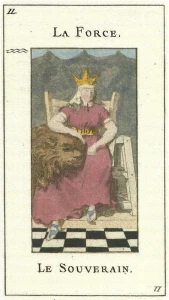
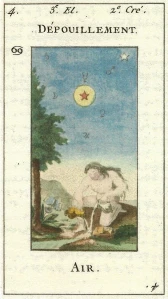
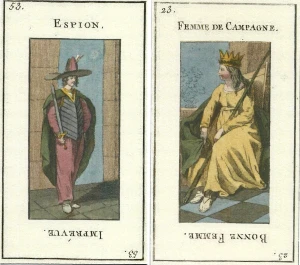
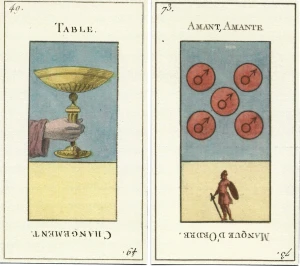

If anyone can do this deck justice, it’s Marco! Thank you for writing this article. I already have 2 different Etteilla publications, but now I just might need this one. Lol. ~ Marilyn
Marilyn, Thanks for your feedback. Marco’s deck is wonderful to handle. Since I’m a fanatic for the first, and original, of anything, I value his deck for having Etteilla’s original keywords. In addition to those quickly advertisements.
I’m the same way! As close to an original as one can get. Plus, Marco’s decks are luscious and just a delight to shuffle! ~ Marilyn